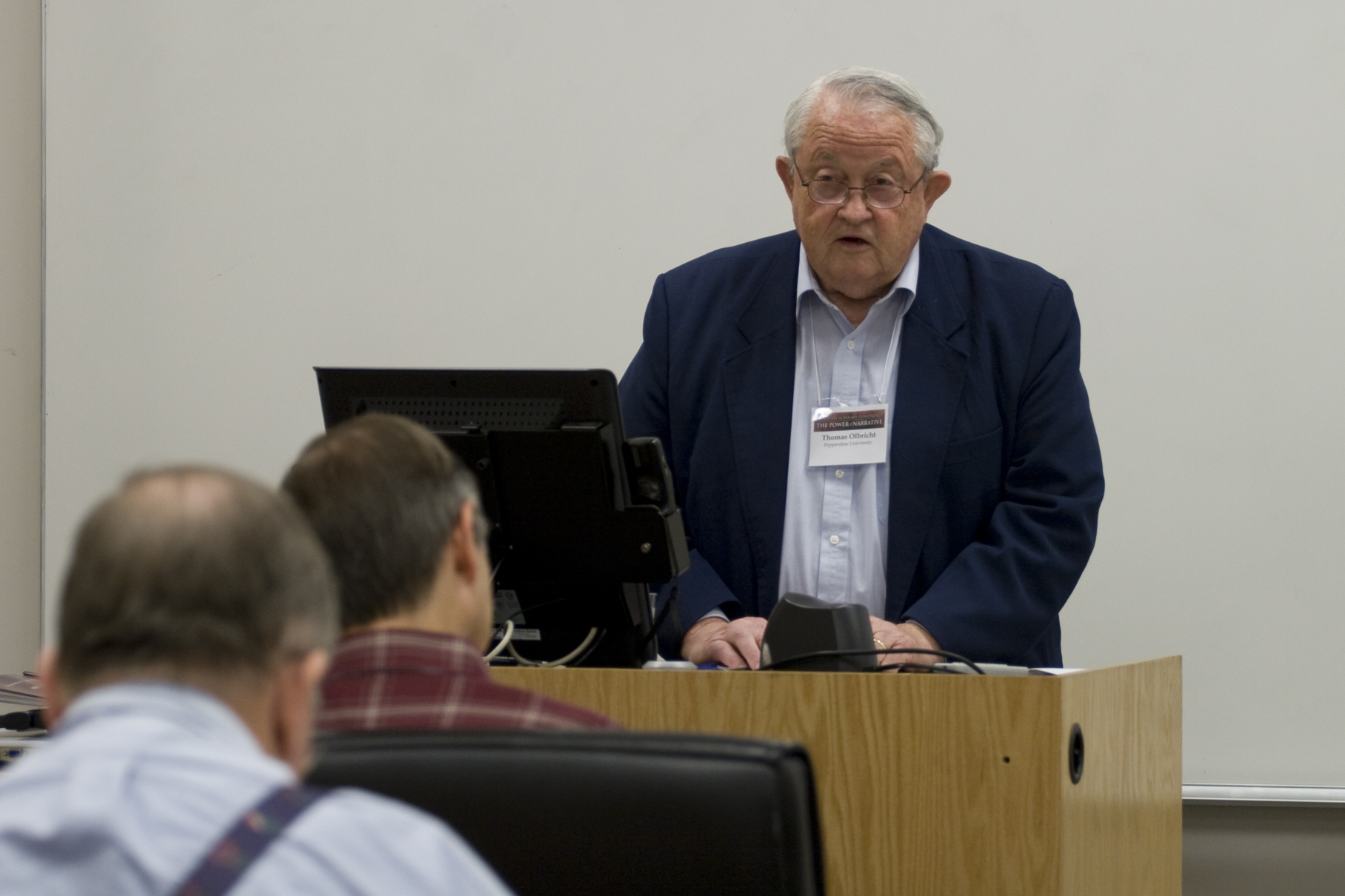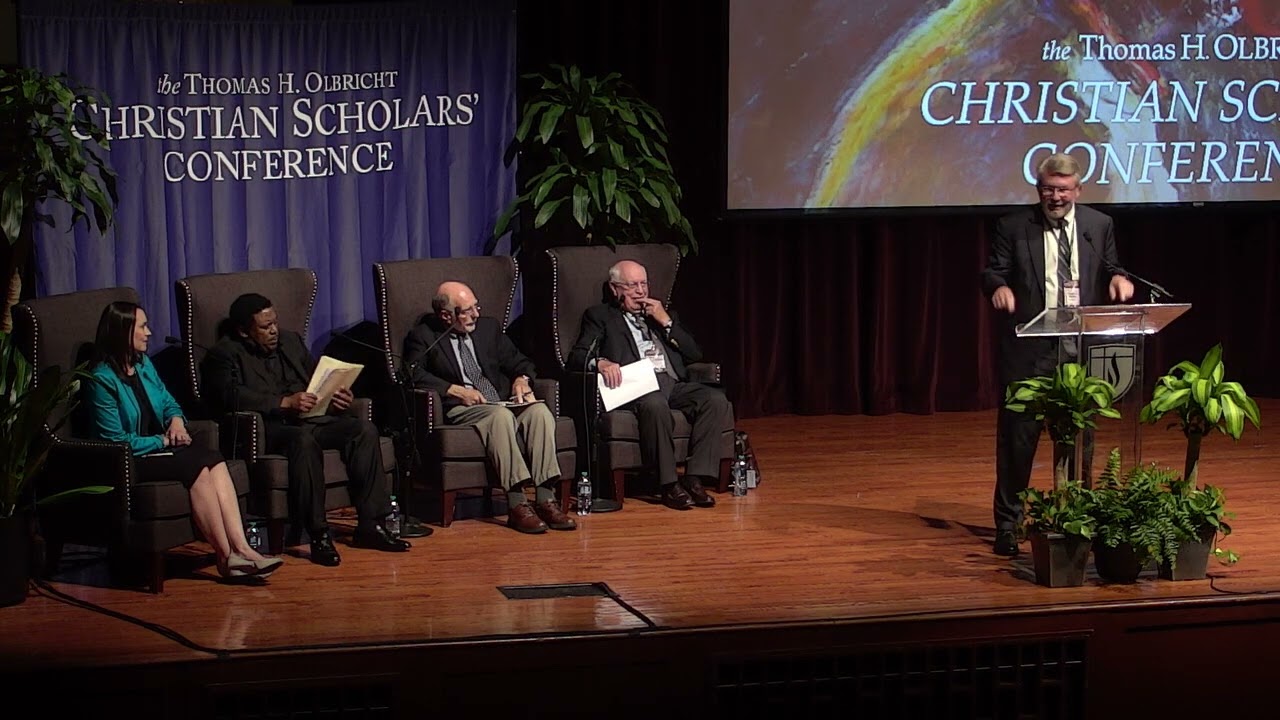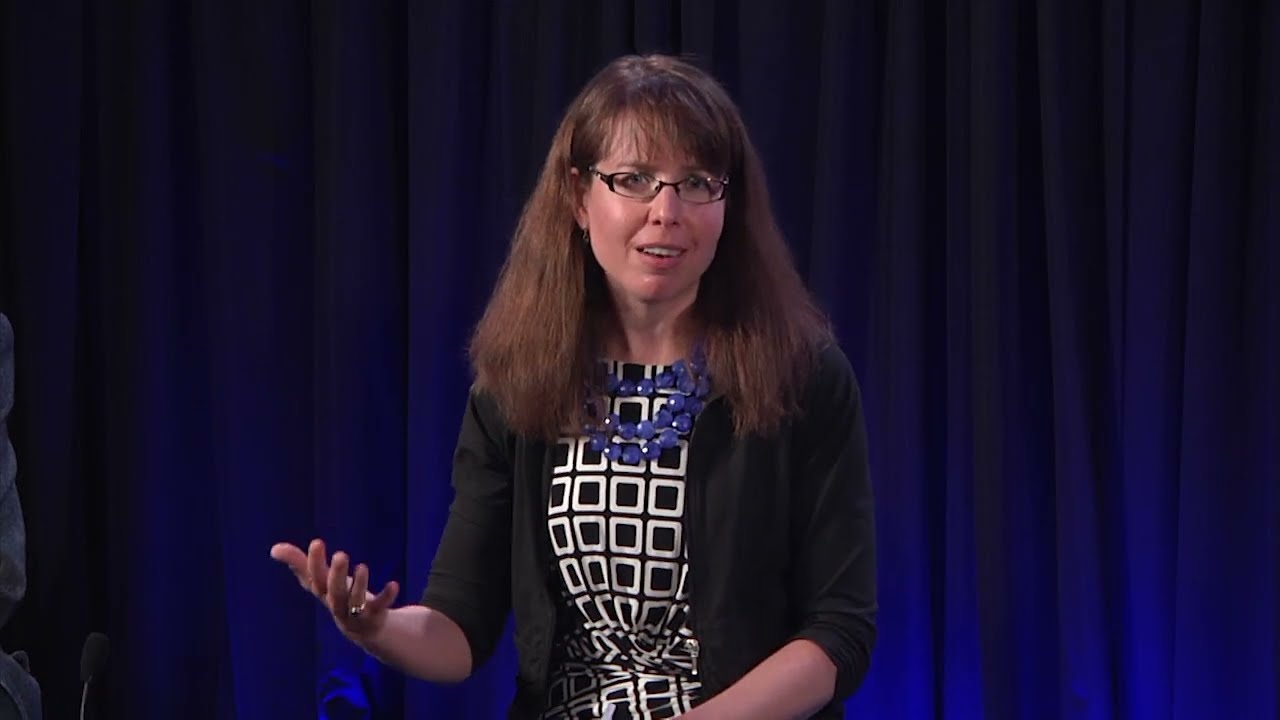
Tom Olbricht as Interpreter of the Old Testament
Volume 1 | June 6, 2022
Theme: Biblical Scholarship, In Memoriam
Discipline: Religious Studies
The editor of Ecclesiastes spoke of Qohelet as one who “sought to find pleasing words and to write true words.” That tribute to his teacher certainly applies to ours as well. Thomas H. Olbricht sought to integrate his own life, the ongoing history of his ecclesial family, and the Bible into a coherent whole. Part of that lifelong project involved the interpretation of the Old Testament.
While his nearly 300 published works focused primarily on the New Testament and the history of the Stone-Campbell movement, as well as on Greco-Roman rhetoric and the history of biblical scholarship, Tom made several valuable contributions to the church’s study of the Old Testament. These include a review of scholarship on Genesis between 1960 and 1980, in which he argues cogently for Hans Walter Wolff’s efforts at working out the theology of the Yahwist in preference to the growing attention to the final form of the text.1 Olbricht showed a deep awareness of the secondary literature, and while he did not exactly mount a defense of the Documentary Hypothesis, he did strongly question the move away from the then standard approaches to historical-critical biblical scholarship. Given the state of the field today, in which the contest between documentary and supplementary models of Pentateuchal origins rages within critical Hebrew Bible scholarship, his skepticism seems well considered, even if we would frame the issues today very differently than anyone could have forty years ago.
Tom also wrote two important chapters in The World and Literature of the Old Testament, a volume in Sweet’s Living Word series, edited by John T. Willis. 2 In “The Making of Old Testament Books,” he embraced a redaction-critical approach (without the label) to Psalms, Proverbs, Chronicles, Amos, and Jeremiah (carefully avoiding the Pentateuch). He concluded that, “The making of the books of the OT is a very complex matter. One can almost offer the suggestion that the rule is that there are no rules.” 3 This assessment is perhaps a bit hasty, though appropriate for his lay audience, whom he wished to lead gently away from a notion of divine dictation of texts, without shoving the whole apparatus of source, form, and redaction criticism in their faces. Given the hostility to form and source criticism in church circles at that time, his approach showed considerable courage.
Tom’s gentle yet thoughtful strategy also informed his article on Old Testament theology in the same volume. After detailing a few of the major volumes in Old Testament theology influential at that time, he cataloged a series of topics that appear in numerous Old Testament texts, concentrating (to use his language) on the God who creates and sustains, makes promises to the “fathers,” acts in Egypt and the sea, trains His son [i.e., Israel] in the wilderness, “puts it in writing” [i.e., makes covenants] with Israel, cares by giving law, commands the heavenly armies [i.e., in the settlement in Canaan], gives his son [again, Israel] an inheritance, and makes a promise to David.
This list of topics is interesting for its radical theocentrism, its downplaying of Christological readings of the text, and its insistence that the Old Testament constitutes an indispensable witness to the work of the God whom the church worships. Without directly controverting the Campbellite approach to the Old Testament as he inherited it, and as many of us were still taught in the 1970s and 1980s, Tom offered a view of the Old Testament that sharply contrasted with the supersessionism still all too prevalent today in many corners of the evangelical church. He moved readers away from a negative view of Torah, interpreting it as a gift from a loving God. And perhaps most crucially, he shifted the concerns of readers away from human actions toward divine actions.
Olbricht’s basic understanding of the theology of the Old Testament did not change much over time, for this same basic outline appeared in his much later article in the one-volume commentary, Transforming Word.4 It also provided the structure to his most important contribution to the church’s study of the Old Testament, the 1980 volume, He Loves Forever.5 This short volume was last reprinted in 2013, and so remained in active circulation for a third of a century, indicating its long-lasting impact.
He Loves Forever introduced lay readers to the narrative structure of the so-called Primary History (Genesis–Kings) plus the stories of life after the return from the so-called “exile.” It also conveyed the sense that the human beings crossing the Bible’s stage form part of a long chain of movement that also includes us. So, to take one of many examples, Olbricht writes of the tragic story of Saul and his displacement by David in 1 Samuel,
Did God make a mistake in choosing Saul? Yes and no. Saul did not turn out as God hoped. In that sense, it was a mistake. But even here the love of God is obvious. God has high hopes for every creature made in his image. He especially wants them to become great leaders . . . .6
It is hard to speculate on how literally to take the idea that God might be mistaken, even though the plain sense of Yhwh’s speeches in 1 Samuel 13 and 15 would seem to support such an interpretation, however naïve that might seem from the point of view of systematic theology. However, the fact that Tom would raise the possibility and then turn it to theological advantage says much about his aims and audience. For an ecclesial community struggling to free itself from generations of sectarianism and closed-in readings of Scripture, framing the work of God as an expression of divine passion for human improvement, and thus subject to either disappointment or gratification depending on human choices, marks a monumental sea change.
Both the outline of the book and much of its content reflected the theological currents of the late 1960s, though Tom was aware of the massive changes in Old Testament theology underway during the 1970s. His own training at Harvard, in the early 1960s had occurred during the height of the Biblical Theology movement, and particularly the synthesis of history and theology then in play under the influence of Gerhard von Rad and, still more, the so-called Albright School. His own teacher, G. Ernest Wright, a student of William F. Albright’s, had not only excavated at Shechem but had written a string of monographs attempting to interpret Old Testament theology as a recital of the mighty deeds of God. These included The Challenge of Israel’s Faith (1946), God Who Acts: Biblical Theology as Recital (1952), and The Old Testament and Theology (1969).7 Perhaps most influential in the construction of Tom’s own volume was one that Wright and Reginald Fuller had co-authored called The Book of Acts of God (1960).8Wright and Fuller argued that, however disparate the Christian Bible seems, its “central concern is to bear testimony to the story of what [God] has done to save man and to bring his kingdom into being on this earth. Central to the Bible is the history of a people . . . .”9 This generalization allowed them to include texts such as the prophets and Wisdom, the latter of which notoriously does not easily fit within a theological framework whose dominant elements can be categorized as either history or the recital of history. Indeed, Wright and Fuller are quite vague on this point, as became clearer later in ongoing reflection on the theological import of the Wisdom texts, and indeed as became most urgent as the Albrightian synthesis collapsed in the 1970s and 1980s under the pressure of increasing sophistication both in archeology and in theology.
But the collapse of that synthesis lay in the future of Tom’s work in He Loves Forever, and indeed it would hardly matter to his overall project of reciting the Bible’s story and locating even non-narrative texts (like Proverbs or Psalms) within it. In the latter case, a book like Proverbs becomes the testimony of many people to the way the world works (properly or improperly). That process of discernment equals the study of nature. “Therefore,” Tom argues, “when a man sorts out the ways of nature through experience, his conclusions come from God because they are God’s ways.”10
One might, of course, quibble with such a project at any number of places, and this was true already when it was first published. He Loves Forever represented the state of the field just as it changed dramatically. But no matter. The book was not aimed at the scholarly guild, nor did it attempt to do more than open the eyes of a deeply sectarian movement to the larger meanings of its own Scriptures. The pioneering work of Tom Olbricht (as well as John Willis and Jack Lewis) made it possible not only for some of us to publish and teach as Old Testament scholars within Churches of Christ, but for preachers to advert to the first three-fourths of the Bible without apology or harmonization. Tom’s work was always the most theologically oriented of the three, and while far less prolific on the Old Testament than either, his retrieval of an explicitly theological structure of three-fourths of the Christian canon had an influence on preachers and teachers, especially his students at ACU and Pepperdine, that would be difficult to measure.
On the Future
I turn, finally, to the question of legacy. Today we are seeing a true flowering of Old Testament scholarship in Churches of Christ, not only among present or former members of our group who teach at prominent universities outside our orbit, but within our own schools. But at the same time, not all the story is quite so positive. Late last year, I took an informal survey of colleagues at several Church of Christ–affiliated schools, women and men who publish extensively at the highest level, serve on committees in the Society of Biblical Literature or the Catholic Biblical Association, and, in short, exhibit all the markers of engagement with scholarship in its many forms. Most of them spoke of a bittersweet relationship with their local congregation and Churches of Christ more generally. They spoke of how their fellow Christians simply did not listen or would ignore what they said even about the Old Testament, where they had genuine expertise. They also registered discontent with the theological thinness of so much of church life. They are not, at least in my judgment, whiners or hectoring critics. Rather, their statements signal a problem in our church’s life.
Olbricht noted a similar issue in a paper delivered at the first Christian Scholars’ Conference, held in Abilene in 1981.11 In response to the self-posed question, “what direction should religious scholarship take among us now?” he gave a step-by-step answer. He asserted that faithful scholarship (1) rests on confession of God as the Father of Jesus Christ, (2) presupposes that “our insight into God and our response to and walk with him are set forth in the Old and New Testament Scriptures,”12 (3) affirms that our “walk with God” requires understanding the Bible, (4) insists that understanding Scripture means “discovering and emphasizing the heart of the Biblical faith,”13 (5) calls upon all Christians to take responsibility for studying the Bible using grammatico-historical tools, and (6) depends on a liberal arts education that can teach the skillful use of those tools.14 In short, he offered a vision of theological scholarship as an enterprise equipping the church for greater spiritual maturity and aiding an audience deeply desirous of availing itself of such learning.
For Tom, such a vision had a certain urgency. “To ignore,” he warns, “Biblical theology as we have done through much of history leaves us open to the proliferation of splits and parties among us.”15 The crucial point: failing to take seriously “the heart of the Biblical faith” leads inevitably to division and all its attendant horrors. This attitude, I would argue, reflects the restorationist impulse at its best. Outcomes and agreement pale in significance compared to the ongoing humble pursuit of truth by persons who take responsibility for their own spiritual growth through a deeper understanding of Scripture.
How close are we to realizing that vision? God only knows. A certain pessimism seems abundantly justified. Yet, we human beings must avoid the twin temptations to complacency or despair. And here is where I think Tom Olbricht still helps us most. On the one hand, much of the vision for Churches of Christ that his generation of leaders laid out in the 1970s and 1980s did not materialize. Many of us simply substituted the narrowness of American evangelicalism for the narrowness we inherited. But on the other hand, the core Christian story involves death preceding resurrection. Perhaps the death of our structures or even our entire denomination need not be a fearful thing but a moment of divine wonder, because the “heart of Biblical faith” that we must work together to discover—and which scholars can help elucidate—can surely still draw us forward.
This hopeful note allows me to make my final point, which was also my first. For Tom, the work of theology was, in large measure, a process of self-discovery. His three autobiographies, numerous essays on New Testament, rhetoric, and the Restoration Movement, as well as his work on the Old Testament were all of a piece, their extraordinary variety notwithstanding. We must ask ourselves how our own scholarship reflects a similarly coherent stance toward life. What does it mean to be a theologian (of whatever disciplinary variety) for the sake of, and because of, the church? We must keep asking the question because our very humanity is at stake. This realization is Tom’s greatest scholarly legacy, in my view. Let us pursue its implications.
- Thomas H. Olbricht, “The Theology of Genesis,” Restoration Quarterly 23 (1980): 201–17.
- Thomas H. Olbricht, “The Making of Old Testament Books,” in The World and Literature of the Old Testament, ed. John T. Willis (Austin, Tex.: Sweet, 1979), 225–57; and idem, “The Theology of the Old Testament,” in World and Literature, ed. John T. Willis, 296–345.
- Olbricht, “Making of Old Testament Books,” 256.
- Thomas H. Olbricht, “Old Testament Theology,” in The Transforming Word: One Volume Commentary on the Bible, ed. Mark W. Hamilton, et al. (Abilene, Tex.: ACU Press, 2009), 69–76. The original manuscript included some updated readings (especially the work of Walter Brueggemann), but most of the updating in the article’s bibliography came from the volume editor, the present author.
- Thomas H Olbricht, He Loves Forever: The Message of the Old Testament (Austin, Tex.: Sweet, 1980; reprint ed. Joplin, Mo.: College Press, 2000).
- Ibid., 127.
- G. Ernest Wright, The Challenge of Israel’s Faith (London: SCM, 1946); idem, God who Acts: Biblical Theology as Recital, Studies in Biblical Theology 8 (London: SCM, 1952); and idem, The Old Testament and Theology (New York: Harper & Row, 1969).
- G. Ernest Wright and Reginald H. Fuller, The Book of Acts of God: Contemporary Scholarship Interprets the Bible (Garden City, N.Y.: Doubleday, 1960).
- Ibid., 43.
- Olbricht, He Loves Forever, 155.
- Thomas H. Olbricht, “Religious Scholarship and the Restoration Movement,” in Papers Delivered at the First Christian Scholars Conference, Abilene Christian University, July 1981, 121–40. Reprinted in Restoration Quarterly 25 (1982): 193–204.
- Ibid., 137.
- Ibid., 138.
- Ibid., 139–40.
- Ibid., 138.



